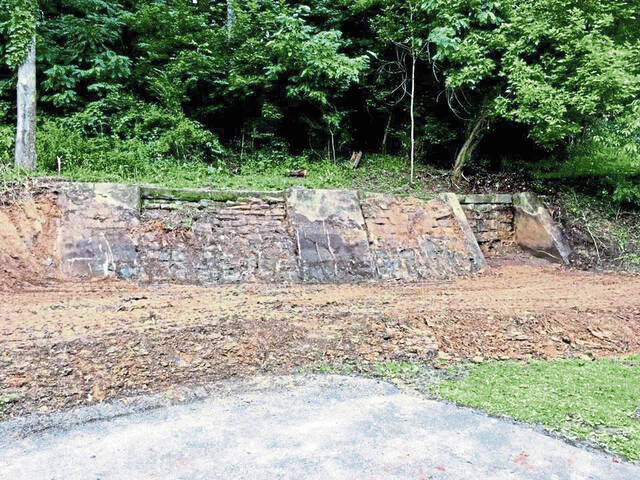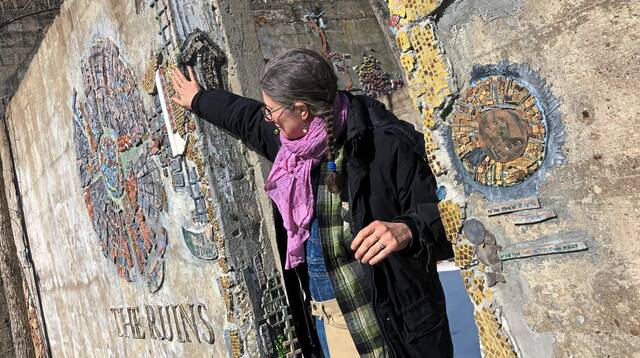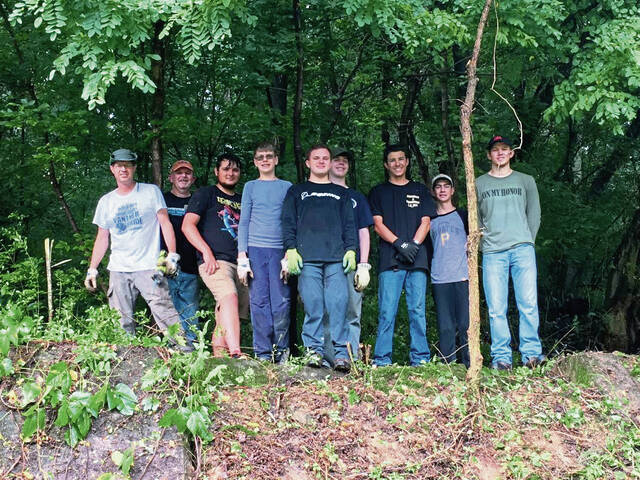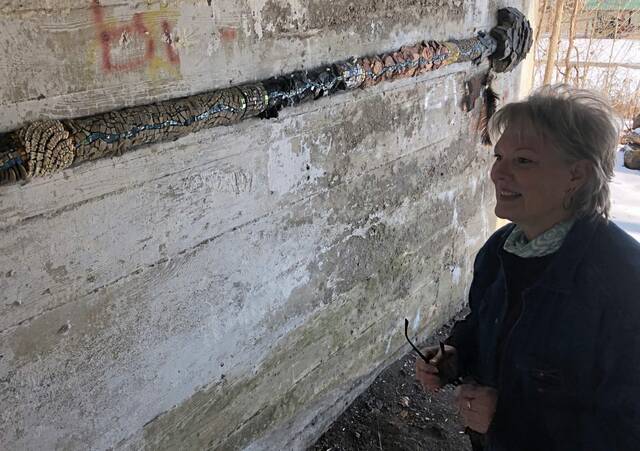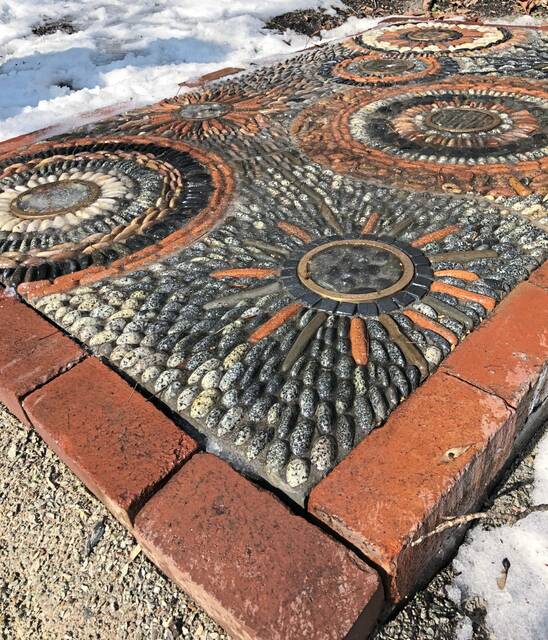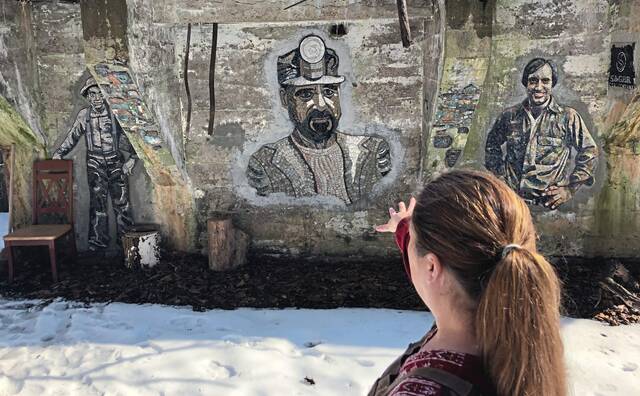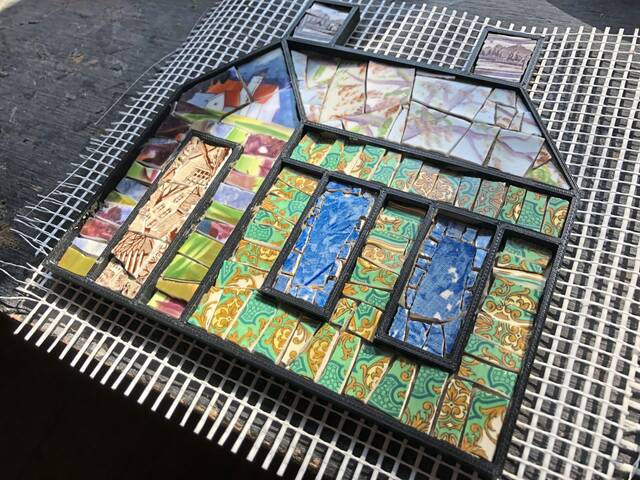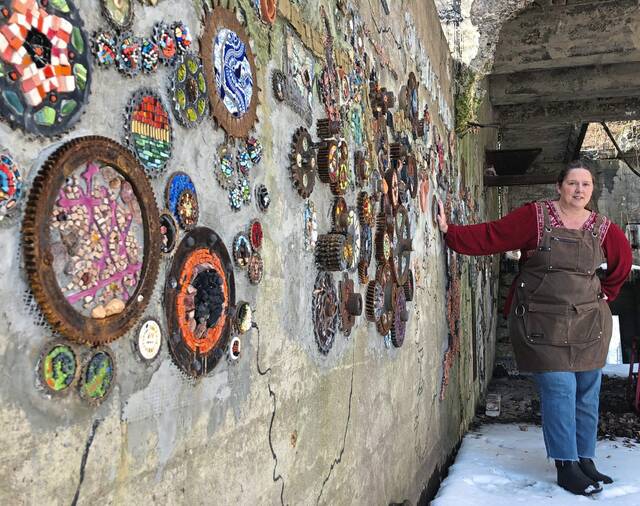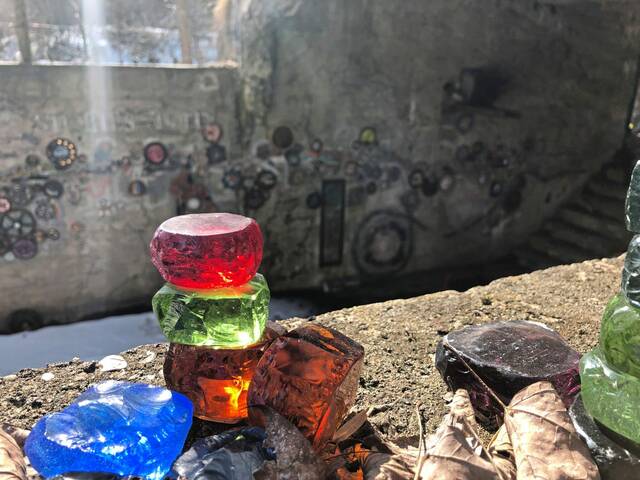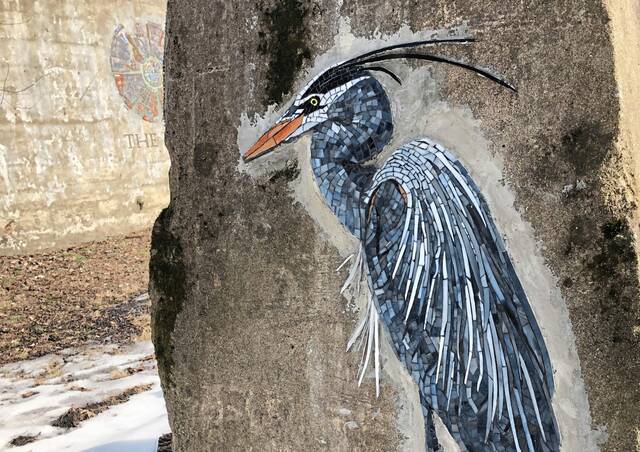Western Pennsylvania residents look to preserve region's mining history
On an unusually warm day in what would normally be the dead of winter, melting snow perfectly illustrated why an old Pittsburgh Coal Co. mine in Fayette County is now called “The Ruins.”
“Nature takes a backseat to industry, but it always wins out in the long term,” said Rachel Sager, owner of Sager Mosaics and, one might say, art curator for The Ruins — a former processing plant off River Road in Whitsett that is slowly being taken over by moss, vines and the freeze-thaw cycle.
Sager has recruited more than 200 artists from around the world — many local — to turn the former industrial site into a living artistic monument to the men who went into the mines, and the families who watched them walk out the door every morning, not knowing if they’d return.
The art installation sits just off the Great Allegheny Passage. Sager charges for hourlong tours by appointment to showcase the artwork and tell the region’s story.
Meanwhile, in Export
A few miles north in Export, the local historical society is trying to preserve its own mining history, working with the state’s Bureau of Abandoned Mine Reclamation to convert the former Westmoreland Coal Co. mine entrance off Brick Hill Road into a usable historic area.
“They’d like to make it a more-secure opening where we’d install a ventilated, concrete-block seal to prevent people from entering the mine,” said Robert Kudlawiec of Tetra Tech, an international engineering and consulting firm with offices in Pittsburgh working with Export on the project. “We’d use our engineering skills to seal off those two portal openings, remove some of the earthen material between the two portals and secure the concrete in that area.”
The entrance was once completely buried in the hillside behind the local district court office. It was uncovered a few years ago as part of a local Eagle Scout project. Since then, Export Historical Society officials have been hoping to use it as a way to showcase the borough’s history, which includes its one-time status as Westmoreland County’s largest single mining operation in the early 1900s.
‘The Ruins’ work
Sager said the main idea behind The Ruins is to showcase Fayette County miners’ stories, particularly those of the Banning No. 2 mine, which was open from 1893-1946, when the Industrial Revolution truly began building the modern United States.
“Pittsburgh has really been able to reinvent itself and use its history to help do that, but the history out this way sometimes gets forgotten. You have the ‘melting pot’ metaphor, and it’s really apt for Pittsburgh because of the steel industry,” she said, then gestured over her shoulder to the mine behind her. “But the coal from these mines is what made those ovens fire up.”
The Ruins project began seven years ago, and has incorporated the work of artists from as far away as England, Tasmania and Australia. But most of the pieces have come from local artists, like Beverly Niccolai of Belle Vernon, Wendy Casperson of McKeesport an Erika Johnson of Pittsburgh’s Morningside neighborhood.
“One of the things I really like about Rachel is that she’s created opportunities for people like myself and Wendy to contribute and create,” Johnson said.
Niccolai has painted several trees on the processing-plant walls, whose branches are now occupied by mosaic birds that are part of the “Feather Project.” She said she is sometimes overwhelmed by the emotions The Ruins invoke when she visits.
“When I walk up the hill, I cry,” she said. “I see the mosaic of Rachel’s father, and I say a little prayer to give me the strength to paint something beautiful.”
Since 2015, Casperson has been working on a Native American arrow that will one day run from end to end along one of The Ruins’ walls. She took one of Sager’s mosaic classes in 2012, which focused on foraging for mosaic materials.
“I just fell in love with what was going on down here,” Casperson said.
In fact, the mosaics themselves help tell the history of the Banning No. 2 mine. Tiny terracotta-colored flowers which dot the main entrance are made of “red dog,” the mining byproduct of shale that has burned underground for months or sometimes years.
“Everyone around here had it in their driveway,” Johnson said.
That same entrance is also adorned with “smalti,” Italian-made mosaic tiles with real gold layered between thin sheets of glass. Sager recovered the smalti from a demolition project at St. Pamphilus Church in Beechview, where a religious grotto had been vandalized.
“The congregation built the grotto themselves in the 1950s,” Sager said. “I’d like to invite them down to see how we were able to use it.”
From eyesore to feature
In Export, the historical and decorative elements are still a bit down the road. Councilman and historical society member John Nagoda said the borough has three shovel-ready projects he’s hoping will qualify for $241 million in mine-reclamation funding announced by the state this month.
“We have the mine entrance; a borough park that used to be an old mine dump where we’ve done a lot of our work but don’t have the money finish it; and we have acid mine drainage coming out of property the borough owns near White Valley,” Nagoda said. “I think we have a very strong standing to get money to finish these projects.
“These can be turned from an eyesore into a feature.”
Next up at The Ruins
That was certainly the objective for Sager, who is looking to potentially double the number of artists contributing to The Ruins with her next venture, a “Patch House” project of mosaic quilts, named for “patch towns,” the company-built mining towns that sprung up near the mines to house workers.
The quilt “patches” will each be a house, made from a basic template Sager created. Two will be made from stone and other more-common mosaic materials. Casperson, however, is helping with the “picassiette” quilt, meaning “plate thief” in French.
The mosaic tiles will be made entirely from broken plates.
“The idea is to celebrate the ‘patch town’ idea using a patchwork quilt,” Sager said. “It brings the family into the story.”
The “Patch House” project will be unveiled in late spring.
Nagoda said the history of places like Export and Banning No. 2 need to be preserved.
“Export has always been part of an east-west thoroughfare, from the Indian paths to the Northern Pike, the railroad, old Route 22, new Route 22,” he said. “It’s a path that’s been traveled for hundreds of years and continues to be traveled.
“Those stories need to be told.”
For more on The Ruins, see Ruins.sagermosaics.com.
Patrick Varine is a TribLive reporter covering Delmont, Export and Murrysville. He is a Western Pennsylvania native and joined the Trib in 2010 after working as a reporter and editor with the former Dover Post Co. in Delaware. He can be reached at pvarine@triblive.com.
Remove the ads from your TribLIVE reading experience but still support the journalists who create the content with TribLIVE Ad-Free.


